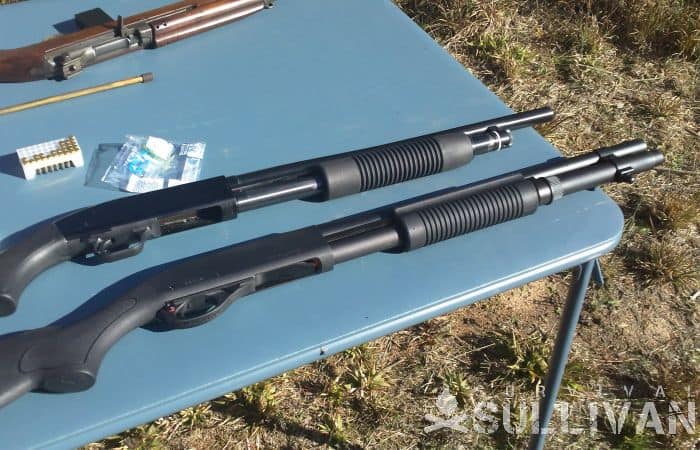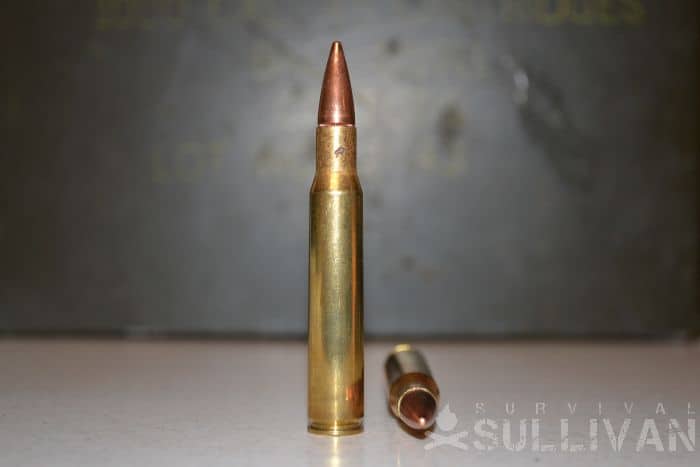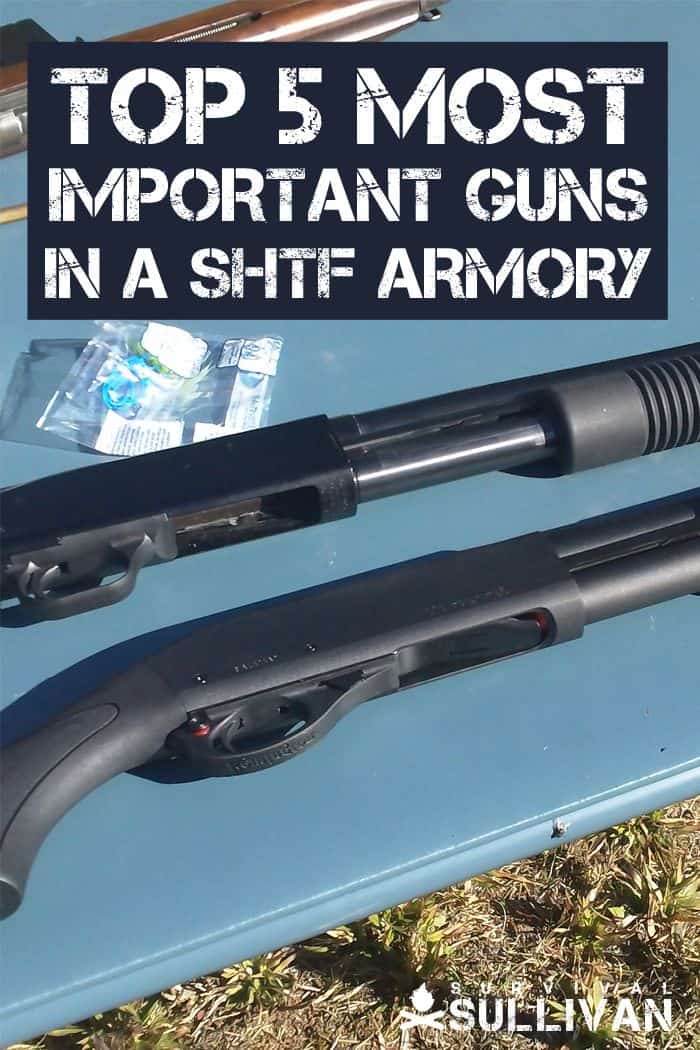There are many potential ways that disaster could strike: economic collapse, natural disaster, EMP attack, terrorist attack, and so on. Regardless of the specific disaster that comes your way, what’s important is that you be appropriately armed to handle any security threats that could result from that disaster.
While you don’t have to buy enough guns to literally fill up an entire room, you will want to buy enough guns so that all of your bases are covered.
In this article, we’re not going to point out any specific makes or models of guns that you should have. We are going to outline the five most important types of guns that you should own and suggest the order in which you should own them:

A 12-GAUGE OR 20-GAUGE SHOTGUN
The first gun that you will want to have in your SHTF armory is a shotgun, chambered for either 20 gauge or 12 gauge. Semi-automatic shotguns are an excellent choice for self-defense, due to the fact that you can place multiple rounds down range in a matter of seconds.
This way, if your attacker is using the element of speed and violence to gain superiority, you can counter it with multiple slugs to the chest. Make sure you use discipline when placing multiple rounds downrange, because the more rounds that you shoot, the less ammunition you will ultimately have. Use common sense.
The reason why a shotgun should be the first gun you own is its versatility. If you think about it, the only two ways you can’t use a shotgun are for concealed carry and long range shooting. However, you can use it for two of the biggest reasons to own a gun: hunting and home defense.
While you can obviously go small game or bird hunting with a shotgun when it’s loaded with birdshot, you can also go big game hunting when you load it with slugs. It won’t have quite the range of a rifle, but it will definitely have enough power.
Buckshot and slugs are both great loads to use for home defense. Buckshot delivers more power than birdshot and more spread than slugs, but slugs have less of a risk of collateral damage behind your target should you miss.
When looking for a shotgun, look for a model that you can fit with an adjustable/removable choke. By adding an adjustable choke, you can greatly reduce the spread with buckshot should you use it for home defense (or birds that are high in the air with birdshot).
For slugs, simply remove the choke (unless it’s compatible) so you don’t damage it. This will essentially give you two shotguns in one and greatly increase the versatility of the weapon.
SEMI-AUTOMATIC PISTOL
After your shotgun, probably the next most important gun to own is a semi-automatic pistol. This is debated by many who say the next you should own is a .22 rifle. Nonetheless, the pistol gives you a unique capability that rifles and shotguns don’t, you can conceal it on your person.
This will be a huge advantage in an SHTF situation where you may not want anybody to know that you have a gun on you and want to preserve the element of surprise.
While some shooters prefer revolvers for their simplicity, you should opt for a semi-automatic pistol with a large magazine capacity (10-15) instead. This is simply because you’ll have to reload less often. And it’s always better to have more rounds against multiple assailants.
An ideal semi-automatic pistol would be a mid-sized pistol with a large magazine capacity. (Something along the size of a Glock 19, though many other makes and models exist).
This is because a mid-sized pistol will be small enough to conceal adequately, but large enough to be used effectively in an SHTF situation with its higher round count. 9mm, .40 S&W, and .45 ACP should be the only calibers you consider for your pistol as they are the most abundant and easiest to find.
In addition to your pistol, plan on having a minimum of five magazines in total for it. By no means should you carry all five magazines at once. However, it’s still a good idea to have spares if any become lost or damaged (plus, you can leave your spares in your vehicle just in case).
You should also have a variety of high-quality holsters (OWB holster, IWB holster, Blackhawk, etc.) that you can use for a variety of different situations.
A .22 SEMI-AUTOMATIC RIFLE
Some would say that the .22 rifle is even more important than the semi-automatic pistol. While you can’t conceal carry it by any means, it’s still almost as versatile as the shotgun. It’s an excellent weapon for general homestead and training use.
The biggest benefit of the .22 rifle is the .22 ammunition itself. It’s incredibly small, and lightweight. This means that can be stored in bulk in the same amount of space that you could only store a rather meager amount of pistol or rifle ammo in.
For this reason, alone, the .22 makes an excellent training weapon because you can have plenty of ammunition to spare. Granted, the price of .22 has been higher in recent years than it was previously, but you can still store a lot of it.
The .22 is also an excellent caliber for small game hunting, and even for deer hunting if you need it to. While a larger caliber would certainly be preferable for bringing down larger game such as deer, if you shoot behind the ear with a .22 it will drop it.
I wouldn’t count on being able to bring down a deer with a .22 as your primary caliber, but in a desperate situation, it’s definitely not out of the question.
Go with a semi-automatic for your .22 over a single shot, bolt action, or lever action. A semi-auto will more closely mimic your semi-auto rifle for training purposes. It can also hold more ammunition (a high capacity mag for a Ruger 10/22, for instance, can hold 25 rounds of ammunition).
A SEMI-AUTOMATIC CENTERFIRE RIFLE
The next weapon you should own is a military style, semi-automatic centerfire rifle chambered in an intermediate round (preferably either 5.56x45mm NATO or 7.62x39mm)
Get one with a large magazine capacity of 20 to 30 rounds, this way you’ll spend less time reloading, and more time shooting.
The primary purpose of owning a semi-automatic centerfire rifle is to defend your family and your property from multiple attackers.
A rifle like an AK-47 or an AR-15 offers you plenty of advantages that no other gun does. It has greater capacity and more range than a shotgun and more power, velocity, and range than a handgun.
A shotgun is great for close quarters home defense, but a semi-auto rifle is far superior for defending your property against mobs of people and looters. With the larger magazine capacity, you’ll have less reloading to do.
Also, the semi-automatic function means that you can send a lot of lead down range very quickly. Make sure you practice your accuracy, otherwise you’ll just be spraying lead without hitting much. Thus, you’ll lose a lot of valuable ammunition very quickly..
Plan on purchasing at least ten spare magazines for your semi-auto rifle. Like with your pistol, by no means do you need to carry all of those with you at once. But it’s still very wise should any become lost or worn out.
While you can buy an optic for your rifle if you want to, it would be wiser to learn how to shoot with iron sights first. The money that you would have spent on an optic or a scope you should instead spend on ammunition for practicing.
If you wish to purchase an attachment, the first one you should buy is an angled foregrip. Foregrips help assist with accuracy during a rapid-fire engagement, as well as your agility while moving and shooting.
A LONG RANGE RIFLE
A weapon that you will need a scope for, however, is the fifth and final gun; the rifle. Regardless of whether it’s a bolt action, lever action, single shot, or another semi-automatic, it needs to fire a bigger bullet and be capable of hitting targets accurately at long distances.
Your long-range rifle serves two primary purposes: big game hunting and long range anti-personnel use. There is no better rifle for big game hunting such as deer or elk than a large caliber rifle. It will also offer you more range than your semi-automatic, intermediate cartridge rifle would.
As far as calibers are concerned, you have a variety of options, but it’s hard to go wrong with .308 Winchester or .30-06 Springfield.
Both are very plentiful and offer you plenty of range and velocity. They will drop anything almost any large game in the United States with a well-placed shot. Their extensive use by the U.S military proves their combat readiness.

CONCLUSION
In conclusion, if you could only have five basic types of guns in your survival armory, a shotgun, semi-automatic pistol, .22 semi-automatic rifle, centerfire semi-automatic rifle, and a long-range rifle are the ones to have.
The reason why these five are the most important is that, together, they fulfill every need that would make you want to own a gun. There is no single gun that fulfills every role. Just like you have to have multiple tools in your toolbox, you must have multiple types of guns in your armory.
Now that you know the five basic types of guns that need to be in your armory, the next thing you need to do is to research specific makes and models for each type.
Remember, you want your gun to last you a lifetime. Ideally, it will be passed down to future generations, so assuming you have the money, investing more cash in a high quality and reputable model.
This will be a much smarter move than spending less money on an inexpensive or cheaply-made version.

updated 09/17/2020

Nick Oetken is a prepper, outdoor enthusiast but, most of all, he is our in-house firearms expert. Look out for his articles on guns to find out which ones you need for your survival.

I would add to this list a good air rifle with at least 15 foot pounds of energy. A $180 Gamo Accu, for instance, is highly accurate, and powerful enough to kill squirrel, rabbit and even groundhog, and nearly silently at that. If SHTF and you want stealthy hunting, you’ll want an air rifle. Considering a tin of accurate pellets are around $16 for 500 rounds, you can’t beat the price either. Many other air rifles that fit this bill are right around $200 and come with a powerful enough scope to get the job done.
The Aquila .22 ammo with no gunpowder are quieter that an air rifle and seems to be as deadly.
Why do you recommend a pump shotgun because a semi-auto is not reliable yet you recommend a semi-auto pistol and rifles? That seems inconsistent since the semi-auto actions are all similar.
It’s due to the ammo not the action,
I’d rather have an autoloader than a pump but it really isn’t that much of an issue…..in my opinion.
Reading the same old stuff. All based on surface knowledge and no in-depth learning prior to the writing. How many times are we going to be reading the same old lists over and over again.
I’m really sorry the article is not up to your standards. If you have any comments, feel free to comment here and I’ll approve the comment, thanks.
If you have so much more knowledge I look forward to reading the article you will write on the subject.
Sullivan, you’re right on all. I agree and had already obtained all in your list…. sometime ago. Just kidding you next…. I would’ve written: 1. the gun in my hand(s), 2. the gun in my holster or slung over my shoulder, 3. the hideout gun in my pocket (or leg holster or under my shirt…..) 4. the higher capacity one, longer range one, bigger caliber one in my truck; and last, 5. the one(s) @ home that the first 4 will ensure I get to. Great article.
An excellent article, while avoiding brand recommendations. I have several of each recommendation listed and wouldn’t hesitate to use any of them for the purposes that you suggest. If you have multiple weapons, it is vital that you develop and maintain proficiency in their use.
yes those are the first anyone should have (agree on adding .22 power air rifle NO gas cartridges). but what’s overlooked by so many and very important though can be spendy is the ever beauty .50cal with good glass especially if you have a large amount of property. you can exchange ammo in combo with a desert eagle pistol and carrying swappable ammo hardware is a + for me. .45 lever action and pistols, 5/7 and p90, .44mag and lever action/also mares leg(.45 too), .22 in rifle and pistol. the .50 has been proven over and over & now have designs you barely get ‘kicked’. for long range takedowns of non-dinner targets and psychological affects/effects on bad marauders, the .50 abides. swap applies into that ‘auto’ if one is so inclined as well…
Anti,
.50 cal rifle and .50 cal desert eagle do not use same rounds. .50 cal rifle have much longer bullet and cartridge versus .50 cal pistol round. Only similarity is that the diameter of both rounds are .50 cal (1/2 inch).
Excellent and well thought out article
I like small Derringers on my person or my hubby keeps one in his pocket, a 38 for my purse , usually a 9mm on his hip, another in the glove box and that’s just EDC on a Saturday shopping trip.